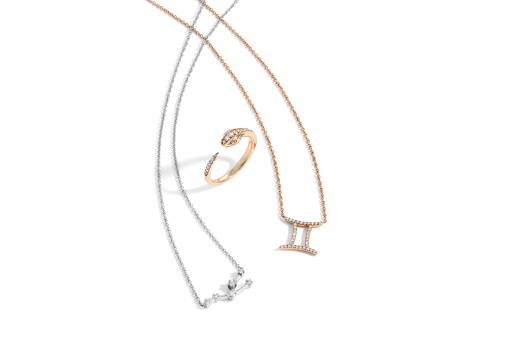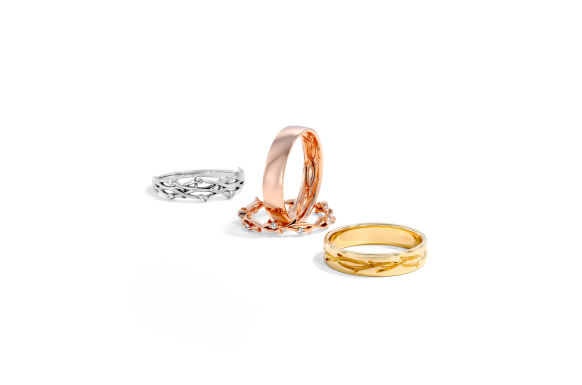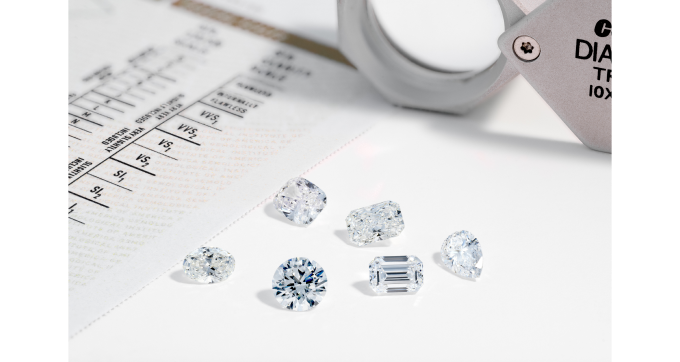We all love the glitz and glam of having a shiny rock on our fingers. And while we’d also love to have the perfect “I do” memento, some budgets are just bigger than others. The good news is, some diamonds are too.
1ct diamonds might be the average size for an engagement ring here in the US, but not all 1ct diamonds are created equal. There is this thing called finger coverage that can take you from fan to fantasy. It’s a little trick we like to call getting more bang for your buck.
It’s The Big One
Contrary to popular belief, there’s no such thing as carat size, a majorly common misconception. See, a carat is actually a universal measure of weight, rather than size, of gemstones.
If you’re looking to get somewhere in the ballpark, carat weight can give you a general idea of how big a diamond will be. The visual size of a diamond varies a bit from rock to rock. It’s affected by several different factors. Namely the depth and surface area of the diamond. We won’t bore you too much with the details, so here’s the easy tea. Shape plays a huge role in visual size, which has a ton to do with glorious finger coverage. Those elongated shapes, think oval, radiant, etc., are doing all the work and making it look easy–and huge.
Cover Charge
So what’s all this fancy finger coverage business? Well, it’s exactly what it sounds like, the amount of finger that is covered by the stone. So you can imagine a shape that’s a bit more shallow and stretched out will have much more coverage than one that’s deep and rounded or square.
The total coverage can vary quite a bit from shape to shape. It’s also affected by your ring size. Smaller fingers will make a stone look larger by comparison. Safe, that’s why, in most cases, elongated shapes are doing the most for finger coverage.
Round and Round
Round brilliants are low-key the most popular diamond shape for engagement rings. They’re a clean, classic cut and give the absolute most when it comes to sparkle and shine. Like literally, they are the most sparkly diamond of all.
Because of all that glittery goodness, rounds tend to look fairly large on their own–but they’re not the biggest.
So when we’re talking diamond-size and throw out, “this diamond looks larger carat for carat,” we’re usually talking in comparison to a round. At least in this article.
Semi Circular
If you love the rounded shape, there’s no beating the round-brilliant. Obvi. But if you’re looking for something that takes up a bit more finger space, we gotta look at fancy shapes. Check it out. Here’s the round-up on our round-ish favs requiring a little more real estate.
Ovals are Everything
Oh-so smooth and semi-circular, ovals are a stellar option for lovers of all things rounded. They’re super popular and look great in just about every setting. Meaning your oval engagement ring will look absolutely sickening in any style you choose.
And yes, they appear larger carat for carat than a round brilliant. Since the cut on an oval isn’t as deep, it has a lot more surface area, which translates into more finger coverage.
Ovals are still incredibly sparkly, so you’re not missing much on that front. They have similar facets to a round, so you can expect oodles of glorious shine.
Perfect Pearing
Ok, so pears are only halfway rounded, but hear us out. They still have a soft look and a delicate vibe. Also, they pack that same brilliant sparkle, obviously a major W.
That gorge teardrop shape gives the pear lots of finger coverage. Also, fun fact, it adds an interesting silhouette to any engagement ring. Sure, they’re not as popular as a round, but that makes them a unique choice, and we love to see it.
Choosing a pear makes it easy to customize your ring and, later down the line, a stunning stack. The rock brings that asymmetrical energy, so you can create an entirely individual look that matches your personality.
Model Vibes
It’s giving Naomi Campbell. Seriously tho, the marquise is long, thin, and majorly in. Ok, so it’s not really round, but it’s got vibes. Those smooth edges and sharp points are absolutely everything–and did we mention loads of finger coverage?
Marquise diamonds are also cut with brilliant-style facets, so you know that sparkle is on point. These gorge little slivers of light have only recently started to become popular for engagement rings. Unique choices much?
That long and graceful line is stunning, slimming, and elongates your finger to boot. All that and it's creating a streamlined and delicate silhouette. We are living for it.
Loving That Elongation
Let’s talk rectangles. Those elongated semi-squared-off shapes are great for finger coverage. They have a totally different look than more rounded stones, so they also create a much different vibe and some stunning silhouettes.
Long Naps
The elongated cushion cut rides the line between circle and square. Its pillowy edges and rounded corners give it a soft look, while its elongated shape creates tons of finger coverage.
That subtle softness is downright dreamy, and that's all thanks to that glittery brilliant sparkle we love so much. Cushions have seriously versatile vibes that go great in most settings. If you prefer a rectangle shape but you really love a mellow moment, it’s the perfect fit.
High Vibes
Radiants, those uber sparkly rectangles with the corners lopped off like an Emerald. Its long stunning shape provides oodles of finger coverage, which is why we’re here, but wait, there’s more!
Radiants have tons of facets meaning tons of sparkle. And that sparkle comes in two different styles. Brilliant, that classic sparkle we love seeing, and crushed ice which is more of a tiny sparkly glitter vibe.
Both cuts are super shiny, but crushed ice also has a bit more of a white face-up look which some people prefer. Brilliants, on the other hand, bring more of an angular look and style to the table. Either way, you’re looking at a whole lot of sparkle.
It’s Giving Glamour
Emeralds have a classic shape and an even more classic vibe. You can opt for a more squared-up Emerald if that’s what you’re into, but elongated (aka traditional) Emeralds have more finger coverage. And isn’t that why we’re here?
Unlike the other stones we’ve mentioned, these shiny stones are step-cut instead of brilliant. This gives them a crystal clear appearance and timeless feel. It also means Emeralds give off bright flashes of light instead of brilliant sparkle. Maybe it’s the clean look, maybe it’s the flashy vibe, but Emeralds are known for the stunning elegance they bring to the table and their timeless style.
Dollars in the Details
Buying a 1ct diamond doesn’t have to cost you an arm and a leg, so here are a few tips to get yourself the best deal whilst snagging the perfect stone.
Round brilliant diamonds are not only super popular, but they’re also the most expensive cut on the market. That’s because some shapes leave less of the raw diamond on the floor when cutting, making them more affordable. Shapes like cushions and princesses are closer to the natural form, but because of their depth, they don’t appear as large. And hey, if you want a square shape, go for it. You’ll still save some money over a round, and those rocks are gorge.
Settings Simply Slay
Settings are another way you can make your 1ct diamond pop. Bands with lots of diamonds can change the silhouette and even make your center stone look larger. Pavé bands are well known for this little trick, but halos are simply the best. A halo can make your center stone look up to one carat larger.
Upgrading the visual size of your center stone with a diamond-studded setting will cost you much less than actually sizing up the rock.
Dainty bands can also make that center stone pop. The more delicate settings contrast with the size of the stone, making it appear larger. Not to mention there are oh so many delightful dainty settings that’ll save you a mini grip while looking absolutely stunning.
It’s Called Finesse
Do you want to save even more money? No problem. There are a lot of factors that can save you a little money here and there, and it all adds up. Check out our education section if you want to dive deep, but here’s the basic rundown.
Clearing Up the Competition
Clarity is a great place to finesse the stone to fit your budget. Many people don’t realize buying a flawless stone is entirely unnecessary–if you can even find one. All that matters when it comes to clarity is finding an eye-clean diamond. VVS diamonds are really as high as it makes sense to go. But if you’re going with a brilliant stone, it will hide many flaws. Rounds are the best at this little trick, but all sparkles hide imperfections.
If you’re looking for lab diamonds, you can start your search for an eye-clean diamond in the VS range. For natural diamonds, it’s worth the extra time to find an eye-clean SI1. You’ll save a ton.
Now, eye-clean is extra important if you are going with a step cut like an Asscher or Emerald. These cuts act like windows, so you can see all the flaws. It’s best to always go VS or higher with these beauties.
Color Me Invisible
If you’re shopping for white diamonds, you want one that appears colorless. But that doesn’t mean you need to buy a colorless diamond.
You can find a diamond that looks absolutely stunning in the G-H range. It’ll appear colorless in any setting and save you some skrilla.
If you’re setting in yellow or rose gold, it’s ok to go a little higher since the gold color will hide a bit of the warmth, so you can go with something like an I color diamond. Just remember, white gold, white diamond, and a G-color stone will still look stunning.
Caution on the Cut
We love to see you save money. Hello, we’re giving away all the cheat codes. But the one place you should never skimp is cut.
The cut is responsible for the look and sparkle of a diamond. Poorly cut diamonds will let too much light escape. They look dark and sad, eew. A well-cut stone will be bright and shiny, which we love, obvi. A good cut on a brilliant stone will also help to hide color and clarity, saving you money in the long run.
Ready To Find Your Something More?
A 1ct diamond certainly isn’t anything to scoff at. But when you find your perfect combo of cut and finger coverage, you can go from good to glam without dropping a penny more.
It’s all about the shape-up, the setup, and the sparkle. When you can have all three–that’s the main character moment to write home about. We’re all about maximizing that bling for your budget, and you finding the right rock is simply music to our ears.






